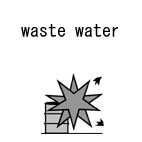| Case Name |
Explosion and fire caused due to a combustible gas-air mixture generated in a toluene drain tank sealed with nitrogen at a hydroquinone manufacturing plant |
| Pictograph |

|
| Date |
March 5, 1984 |
| Place |
Waki town, Yamaguchi, Japan |
| Location |
Chemical factory |
| Overview |
On March 5th, 1984, the drain tank for toluene at a hydroquinone manufacturing plant with a nitrogen blanket exploded and was destroyed by fire. The following factors overlapped with some equipment troubles, and there was an accident.
- The alkali water phase was generated in the toluene drain tank.
- Hydrogen peroxide flowed into the toluene drain tank.
Oxygen was formed in the toluene drainage tank by the above two actions.
- In addition, a combustible gas (toluene vapor) -air mixture was generated in the toluene drain tank and ignited.
The ignition source was considered to be static electricity. These arose in various treatments for the abnormal condition. As countermeasure procedures for abnormal cases had not been prepared beforehand, the situation became dangerous. |
| Incident |
A drain tank (TK-102, a capacity of 200 kL) for toluene at a hydroquinone manufacturing plant with a nitrogen blanket exploded and was destroyed by fire. The explosion blew off the TK-102 roof, and fragments of the roof damaged neighboring facilities. |
| Processing |
Manufacture |
| Individual Process |
Waste water and waste oil treatment |
| Process Flow |
Fig2.Unit process flow
|
| Substance |
Toluene, Fig3 |
| Waste water |
| Type of Accident |
Explosion, fire |
| Sequence |
1. Presence of an alkali water phase in TK-102.
From 20:50 on March 2nd, 1984 to 09:00 on 3rd: The quantity of water in TK-102 was insufficient. A sodium hydroxide aqueous solution was transferred from TK-104 to TK-102 via D-602A.
On March 3rd: A sodium hydroxide aqueous solution was charged into the oxidation reactor for cleaning. The solution was transferred from the bottom of the reactor to TK-102 through TK-103A.
Due to the above two actions, the alkali water phase was present in TK-102.
2. Hydrogen peroxide flowed into TK-102.
On March 5th, 00:00: Temperature control of the neutralization drum D-113 became bad, and the temperature rose. As a result, dissolved water quantity in the oil phase supplied to the next vapor-liquid separator drum D-212 increased. The dissolved water in D-212 was usually drained at the bottom of D-212, but at that time, the drain valve of D-212 plugged. Therefore, water was sent to the oxidation section drain drum D-602A as drain of the oily separator drum D-208 via the coalescer H-311. Then, it was transferred to TK-102. The drain water contained hydrogen peroxide.
Due to 1. and 2., hydrogen peroxide was brought to TK-102 and mixed with the alkaline water phase. Then, oxygen gas was generated and formed a combustible ixture with toluene vapor in TK-102 about 02:30 - 03:30, on March 5th.
About 04:00 on March 5th: An explosion occurred with fire. The ignition source was considered to be static electricity generated by the flow of liquid. |
| Cause |
Hydrogen peroxide was mixed with alkali in the toluene drain tank. Therefore, hydrogen peroxide caused a decomposition reaction, and oxygen gas was generated. Oxygen gas and toluene in the upper vapor phase of the tank formed an explosive gas-air mixture. The ignition source was considered to be electrostatic discharge. It seemed to be safe, because of the nitrogen blanket in the tank, however, the generated oxygen made the condition dangerous.
Some errors overlapped, and the accident happened. |
| Countermeasures |
Improve operational management. Clarify the treatment method in abnormal cases. Review the reporting system, operation standards, and training, etc. |
| Knowledge Comment |
Treatment methods at a plant for an abnormal case should be specified, including methods of reporting and directing. In particular, process waste water has to be examined, considering that it contains chemicals and combustibles. A safe emergency response has to be prepared. |
| Background |
The properties of drainage in an abnormal operation might not be considered beforehand. Also, the overlapping of two abnormal operations was not considered. Precautions against process drain water, which contains organic substances, acid, alkali, etc., were insufficient
This plant was constructed in 1974, and the process design level at that time might not require the emergency study of occurring two or more abnormal situations simultaneously. So, the accident might be inevitable in a sense. |
| Incidental Discussion |
It is a common idea that a tank is safe if it is sealed with nitrogen. However, a tank such as a water waste tank with several flow inlets is not always safe if there is dangerous contamination. |
| Reason for Adding to DB |
Example of explosion caused due to a lack of preparation of countermeasure procedure for two abnormal cases occurred at the same time |
| Scenario |
| Primary Scenario
|
Poor Value Perception, Poor Safety Awareness, Inadequate Risk Recognition, Insufficient Analysis or Research, Insufficient Practice, Lack of Imagination, Ignorance, Insufficient Knowledge, Insufficient Study, Planning and Design, Poor Planning, Poor Tankage Planning, Bad Event, Chemical Phenomenon, Abnormal Reaction, Secondary Damage, External Damage, Explosion, Loss to Organization, Economic Loss, Waste WaterTank Burn-up
|
|
| Sources |
M petrochemical Co., Ltd.: accident investigation committee. The hydroquinone plant accident investigation report. (summary) (1984).
High Pressure Gas Safety Inst. of Japan: Explosion and fire in a toluene drain tank of hydroquinone (resorcin) manufacturing plant. Accident examples of Petroleum refinery and Petrochemical units. pp.152-153(1995).
|
| Physical Damage |
The roof of a toluene drain tank (TK102) blew off. Part of adjacent facilities was damaged. |
| Multimedia Files |
Fig3.Chemical formula
|
| Field |
Chemicals and Plants
|
| Author |
DOBASHI, Ritsu (School of Engineering, The University of Tokyo)
TAMURA, Masamitsu (Center for Risk Management and Safety Sciences, Yokohama National University)
|
|